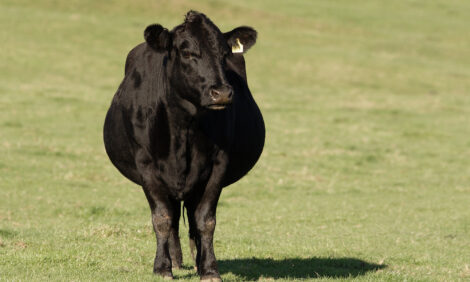



Inbreeding in Cattle
By Sally L. Northcutt, Extension Beef Cattle Breeding Specialist and David S. Buchanan, Professor of Animal Science and Archie C. Clutter, Associate Professor of Animal Science. Contents
ContentsGenetic and Phenotypic Effects
Measurement of Inbreeding
Inbreeding Systems
Uses of Inbreeding
Linebreeding
Effect of Inbreeding in a Seedstock Herd
Recommendations
Inbreeding is the mating of individuals that are related. In the broad sense, all members of a breed are related. As a result, any seed stock producer is practicing some inbreeding. Therefore, we generally reserve the term inbreeding for the mating of animals that are more closely related than the average of the breed.
Genetic and Phenotypic Effects
Inbreeding can have dramatic effects on a herd. These effects are the result of individuals receiving identical genes from each parent. If the parents are related, it is more likely that they have genes that are identical. An individual receiving identical genes from each parent is said to be homozygous for that pair of genes. This would be desirable if the gene the individual received from each parent leads to superior performance. However, most animals carry undesirable genes that usually remain hidden unless the animal is homozygous. An inbred individual is more likely to be homozygous for any gene, so the animal is more likely to express undesirable genes, and hence, undesirable traits.Inbreeding does not create undesirable recessive genes, but it does tend to bring to light these unfavorable genetics. This leads to a decline in average phenotypic performance called inbreeding depression. This phenomenon is well documented in all the major livestock species. Inbreeding depression has the greatest effect on reproductive traits, followed by growth traits, with little or no effect on carcass traits. This pattern is the reverse of the magnitude of heritability for these classes of traits. Inbreeding depression is essentially the opposite effect of heterosis (hybrid vigor), which is the advantage gained from crossing lines or breeds.
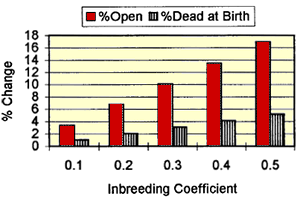 Figure 1. Inbreeding depression for % open and % dead at birth.
|
 Figure 2. Pedigrees for Favourite (252) and Comet (115). |
Figure 2 illustrates a portion of the pedigrees for two founding bulls for the Shorthorn breed, Favourite (252) and his son Comet (115). Both bulls are inbred. The parents of Comet share common ancestors (Favourite, Phoenix, Foljambe, Favourite Cow) in their known pedigree. The parents of Favourite share common ancestors, Foljambe and Favourite Cow. This diagram is a common format for examining inbreeding. The paths between the sire and dam of the individual of interest are used to calculate the inbreeding coefficient.
Measurement of Inbreeding
Inbreeding of an individual is measured with the inbreeding coefficient. The inbreeding coefficient measures the percent increase in homozygous gene pairs in an individual relative to the average of the population from which the individual came. If a bull has an inbreeding coefficient of .25, he is expected to have 25 percent more homozygous gene pairs than a non-inbred individual from the same population.The inbreeding coefficient can have any value between 0 and 1.0, although it is unlikely for it to have a value much above .5 in most herds of livestock. These coefficients are relative to a particular population. It is fairly easy to have it approach 1.0 in plant species where self-fertilization is possible. Also, some lines of laboratory animals have very high average inbreeding coefficients. A few lines of beef cattle and swine that have undergone intense inbreeding for 40 to 50 years have average inbreeding coefficients of .5 to .6. This is accomplished by many generations of brother-sister or parent- offspring matings; therefore, an inbreeding coefficient over .5 is unlikely in a seed stock herd of beef cattle. The Line 1 Hereford cattle developed at the Montana research station would be an example of an inbred line of cattle.
The general formula for an inbreeding coefficient is as follows:
FX = ∑ [(1/2)n+1(1+FA)]
where
FX = inbreeding coefficient of individual X,
∑ = summation sign, indicating that the values in the brackets are to be added together,
n = number of segregations (arrows) between the sire and dam in each separate path through the common ancestor,
and
FA = inbreeding coefficient of the common ancestor in each separate ancestry path.
A common ancestor is an individual that appears on both the sire and dam sides of the pedigree. Whenever a common ancestor is inbred, his/her inbreeding coefficient (FA) will have to be calculated before the inbreeding coefficient of individual X (FX) can be determined. Calculation of an inbreeding coefficient involves several steps:
Step 1: Generate an arrow pedigree.
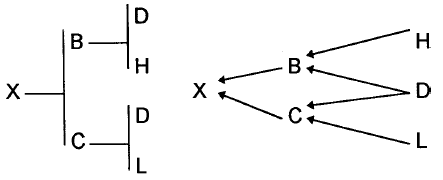
Step 2: List all paths that connect the sire and dam.
Step 3: Locate the common ancestor in each path.
The common ancestor is the individual with the arrows pointing away from it. It is the ancestor that is in the pedigrees of both parents.
Step 4: Determine if the common ancestor in each path is inbred. If so, calculate the inbreeding coefficient for each common ancestor. The rules for determining the inbreeding coefficient of the common ancestor are no different than calculating the inbreeding coefficient of any other individual. If the common ancestor is inbred, simply construct its pedigree and go through each step of the process as if it were the individual of interest.
In this example, the common ancestor is D. Its inbreeding coefficient is assumed to be 0, since neither of its parents are known.
Step 5: Count the number of arrows in each path to determine the value of “n.” In this pedigree, there is only one path, and it has two arrows. Therefore, n=2.
Step 6: Calculate the value of each path connecting the sire and dam of the individual in question.
Value of path = (1/2)n+1(1+FA)
= (1/2)2+1(1+0) (FA= 0 for common ancestor D)
= (1/2)3 = .125
Step 7: Add together the value for each path connecting the sire and dam of the individual in question.
FX = ∑[(1/2)n+1(1+FA)] = .125
Since there is only one pathway in this example, the inbreeding coefficient of X is .125.
Example 1 illustrates the procedures for computing the inbreeding coefficient for animal Z. In this case, the common ancestor S is inbred. The coefficient FZ is the sum of three pathways from parent S to parent D.
Example 1. Calculate the inbreeding coefficient of animal Z
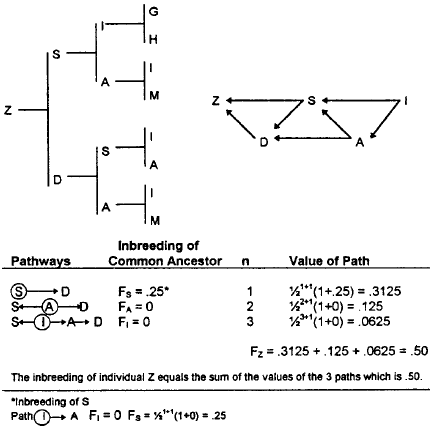
Inbreeding Systems
The inbreeding systems of half-sib, full-sib and parent offspring matings are the most severe types of inbreeding that can be practiced with livestock (Examples 2-4).Example 2. Half-Sibs.
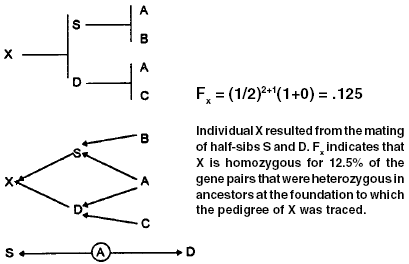
Example 3. Full-Sibs.
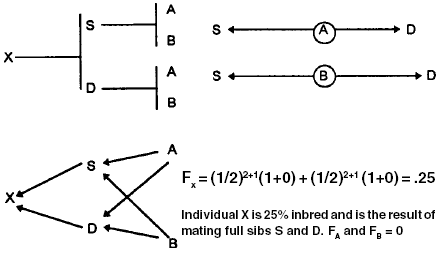
Example 4. Sire-Daughter (parent offspring).

Inbreeding of S contributed to inbreeding of X. If S was non-inbred, FX would have been .25.
Uses of Inbreeding
Inbreeding can have benefits to a seed stock producer if the breeder understands how to monitor it and is willing to sacrifice some performance in the process. Inbreeding tends to subdivide a breed into families which can be identified and crossed with some small benefit. Sometimes these families will have distinguishing features which will aid in recognition. Creation of families is unlikely to contribute to genetic improvement, but it may aid in merchandising if other members of the family have done well. Certain families may demonstrate superior performance, but if a family group has poor average performance, it should be discarded quickly.Inbreeding promotes an increase in pre-potency, which is the ability of an individual to consistently pass on its characteristics. This prepotency results from the increase in homozygosity. Since an inbred individual will have more homozygous gene pairs than a non-inbred individual, there are fewer possible gene combinations for the sperm or egg cells. As a result, the offspring should be more similar to each other.
Livestock producers may utilize inbreeding in three ways:
- Critically evaluate an individual. Critical evaluation of an individual involves testing for the presence of undesirable recessive genes. This process is needed before forming a breeding program around that individual. For example, a planned system of mating may be used to test a sire for an undesirable recessive gene.
- Develop inbred lines for use in a crossbreeding system. Lines of genetically different individuals may be developed using inbreeding. Later, the genetically different lines may be used in crosses. Examples of this practice are evident in the seed corn and poultry industries. Producers interested in developing inbred lines should be cautioned. Response achieved by crossing inbred lines is due in part to recovery from inbreeding depression.
- Concentrate the use of a genetically superior individual (linebreeding). Linebreeding is a milder form of inbreeding, by maintaining a high degree of relationship between individuals in the pedigree, while having a low level of inbreeding.
Linebreeding
All inbreeding does not result in disaster when the use of inbreeding centers on genetically superior individuals. Linebreeding is probably the best known use of inbreeding. Linebreeding is an attempt to maintain a high relationship to some outstanding ancestor while keeping inbreeding as low as possible. Linebreeding has been attempted in most breeds of cattle. It has the advantage of maintaining genes from outstanding individuals that are no longer available for breeding purposes. Also, it helps in recognition, since the breeder can use the name of the ancestor at the center of linebreeding. This is fine if this ancestor is truly outstanding. Many of the bulls that are the object of linebreeding are probably very good, but this may not be true in all cases. Other dangers associated with linebreeding include the inevitable buildup of inbreeding and the possibility of linebreeding to an inferior son of an outstanding bull.Example 5 is an illustration of linebreeding. The inbreeding coefficient of X is only .125 (i.e., X is 12.5% inbred). Three generations separate X and Z, but they have a high degree of relationship (about 48% of their genes in common). This degree of relationship is slightly less than that of full-sibs (full-sibs are from the same generation and have 50% of their genes in common). Therefore, a high degree of relationship exists between X and Z, but the inbreeding coefficient of X is relatively low.
Linebreeding should be attempted only in superior herds that have difficulty finding outside bulls that are of sufficient merit to improve that herd. The ancestor that is the object of the linebreeding should be clearly outstanding based on performance criteria.
Example 5.
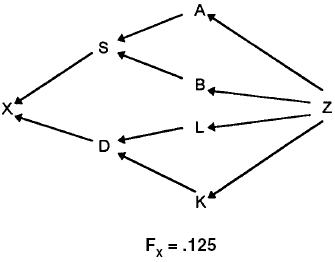
Effect of Inbreeding in a Seed stock Herd
Inbreeding is nearly unavoidable in seed stock herds since it is frequently difficult to find new breeding stock that are not, at least partially, related to animals in an existing herd. Care should be taken to keep inbreeding at a fairly low level by avoiding matings of brothers with sisters or parents with their offspring. Close matings within small herds or family groups not only produce rapid inbreeding buildup and, hence, depression, but can produce random losses of desirable genes.If inbreeding builds up, the first economic effect will be fewer calves available to sell. In addition, the calves will have poorer performance and will not be as attractive to customers interested in performance.
Genetic improvement in cattle originates in seed stock herds. Inbreeding affects the rate of genetic improvement in several ways. There may be a small increase in pre-potency (the degree to which a sire or dam will pass his or her characteristics consistently). This is more than counteracted by the decline in selection intensity and loss of genetic variation. Selection intensity is a function of the proportion of bull and heifer candidates that are actually selected. Selection will be less intense since more bulls and heifers will be needed as replacements, and there will be fewer from which to choose. Furthermore, the variation will be less among the animals since inbreeding reduces intraline genetic variation.
Recommendations
Inbreeding should only be used by seed stock breeders who have a clear understanding of its purpose. Unless approached carefully, the dangers of inbreeding far outweigh the advantages. Perhaps the most important concept to remember about inbreeding is that practicing a high level of inbreeding may result in a decline in average phenotypic merit for various traits. If an animal carries undesirable recessive genes, these genes would be expected to be brought to light by inbreeding practices. Average phenotypic merit would be expected to decline. For example, the decline may impact fertility traits. Results from practicing inbreeding are a function of the genetic merit of the individuals used in the breeding program.Linebreeding can be an effective tool for perpetuating the genes from an outstanding ancestor. It should be used only in herds that are superior, and only those bulls that are clearly outstanding should be the object of a linebreeding program. Mating of close relatives, such as brothers with sisters or parents with offspring, should be avoided.
May 2004


